The Story Behind the Photograph
Photographing The African Bats
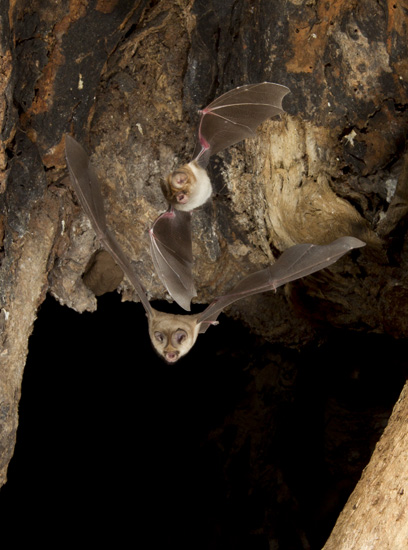
Two African leaf-nosed bats leave their roost hole, made with a Range IR.
I love photographing bats, probably because a flash photograph of a flying bat reveals a view impossible to see with the naked eye. At night, if a bat can even be seen, most views are limited to fleeting glimpses -- perhaps a silhouette against a sky or a fast-moving phantom darting in and out of the dome of a street lamp or porch light.
I was in northern Tanzania where, near one of our camp sites, I found a roosting site for hundreds of leaf-nosed bats. The roost hole opening was fairly small, and although I had several Range IRs along for another project I found that only one was needed to cover the flight path. I only had two nights at the location and, discovering the roost hole at 4PM on the first day I had only a few hours to rig up some type of setup to photograph the bats as they left the roost.
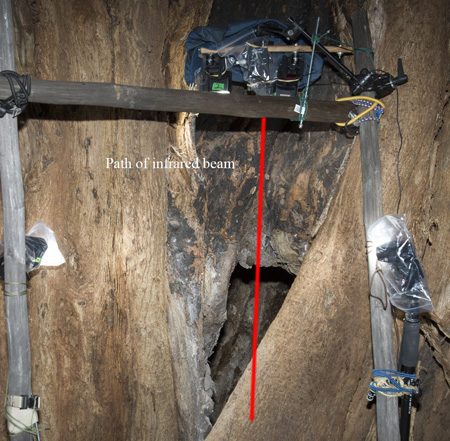 .
.
I did not have lightstands along but using some poles I found nearby I was able to erect a frame where I could mount my flashes and the Range IR. In lieu of lightstands I had carried 1/4 - 20 threaded rods that I had found at a local hardware store back in the States. I brought two different sizes, one 12 inches, and another 24 inches. Since the rods were threaded I could screw in mini-ball heads where I could mount my flashes. I secured the rods to the poles by means of bungi cords and nylon parachute cord, although I had some problems with one rod that was extended out from the mounting pole. That rod, when the flash was attached, swiveled on its axis, resulting in the flash aiming down and not at the hole. By lashing the back end securely, giving two points of contact, I finally made the flash fairly secure.
I wasn't completely unprepared for this shoot because I had planned to photograph bushbabies and genets when I was in Kenya. Consequently, I had along a Manfrotto Articulating Arm, Super Clamp, and a smaller mounting clamp that I used to mount a 1x2x24 inch piece of lumber with several 1/4 20 inch bolts attached, for mounting three or four ballheads. I positioned this piece above the roost hole, with a flash on either side of a Range IR. The Range IR was aimed downward so that the infrared beam covered the center of the roost hole. Since the Range IR has a rheostat-like knob for adjusting the distance the beam travels, I could dial in just enough beam to cover the hole, ending the beam 'in space' so that the ground below didn't trigger the system.
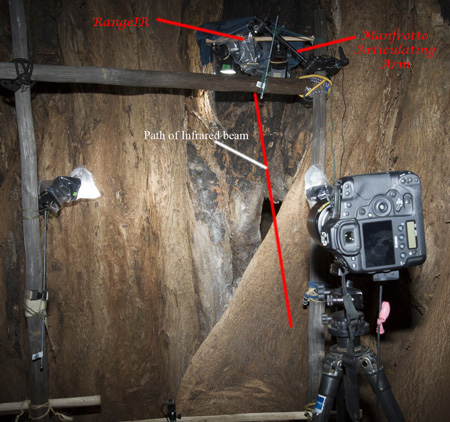
A Range IR, like most camera remote traps, can be attached to either a camera or a flash. In this situation only one method would work. Had I attached the Range IR to a camera, every time a bat broke the beam the Range IR would trip the camera, which would be attached to one flash that would set off the other flashes via a wireless slave system. This sounds great, doesn't it? Exactly what you'd want.
Well, no. Because of the lag time involved, that is, the time that elapses between the time that the beam is tripped and the time the camera actually fires, the bat may have traveled far past the beam. Most dSLRs have a lag time of 1/20th of a second or so, which doesn't seem like much but which really is. A bat might fly 20 inches in that duration! Granted, one could compensate in framing and focusing to catch a bat at the right spot based on this lag time, but each bat would have to be traveling in the same direction and at the same speed. In practical terms, this doesn't work.
 When a flash is wired in, there is no lag time, and so, when the beam is broken a flash fires virtually instantaneously. In this way, if you are focused on the path of the beam and you are framed correctly, you'll get the bat every time. But again, there is a catch: the camera shutter must be open when the flash fires. And, if the flash fires more than once while the shutter is open, the camera will record both (or multiple) images. This can result in double-exposures where a bat appears transparent, as the tree bark behind it is revealed in one of the two shots.
When a flash is wired in, there is no lag time, and so, when the beam is broken a flash fires virtually instantaneously. In this way, if you are focused on the path of the beam and you are framed correctly, you'll get the bat every time. But again, there is a catch: the camera shutter must be open when the flash fires. And, if the flash fires more than once while the shutter is open, the camera will record both (or multiple) images. This can result in double-exposures where a bat appears transparent, as the tree bark behind it is revealed in one of the two shots.
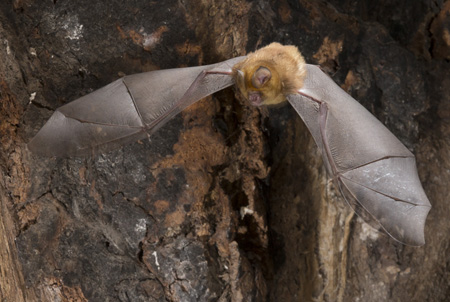 To use the flash, then, I simply put my camera on 'continuous' drive, with the shutter speed set for about 4 seconds. The camera clicked away, sometimes not catching anything in the frame, sometimes (rarely) recording double or multiple exposures, but quite often catching a bat perfectly in the frame. In the dark I couldn't see a thing until the flash fired, when a bat would suddenly be illuminated in wonderful poses. Sometimes, however, the camera's shutter was closed at that instant and I'd miss the shot, but more often than not I would obtain an image.
To use the flash, then, I simply put my camera on 'continuous' drive, with the shutter speed set for about 4 seconds. The camera clicked away, sometimes not catching anything in the frame, sometimes (rarely) recording double or multiple exposures, but quite often catching a bat perfectly in the frame. In the dark I couldn't see a thing until the flash fired, when a bat would suddenly be illuminated in wonderful poses. Sometimes, however, the camera's shutter was closed at that instant and I'd miss the shot, but more often than not I would obtain an image.
I used five flashes for the set-up. Two flashes were mounted on the beam beside the Range IR, another two flashes were mounted on the poles on either side of the roost hole, and the last flash -- the one wired in to the Range IR -- was mounted below the nest hole. I was using a wireless system where the four 'slave' flashes had to 'see' the master flash, and so each flash's receiver was rotated to face the master flash. I used manual mode, rather than TTL flash, because I wanted to have a consistent flash duration, which is not possible on TTL. On TTL, flash duration is based upon f-stop, flash-to-subject distance, ISO, and how much area a subject occupies in the frame. Since the bats' sizes varied by how they positioned their wings this was too variable to risk. On manual, I set my power ratio to 1/64th power, set my ISO at 800, and still had an f16 aperture. The flash was firing at a duration of at least 1/20,000th at the power ratio, although the exact speeds are no longer printed in the flash manuals!
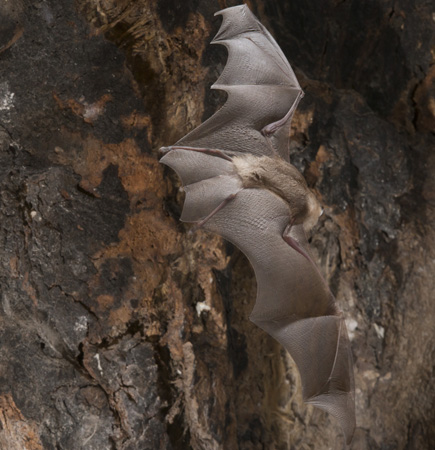
The lagtime issue has been a real hindrance for a lot of this type of work. When I did the striking rattlesnake I had to use Bulb, with the flashes wired to a sensor, because the snake's strike would be completed (that is, the snake would be back in its coil after having struck) before the camera fired. Imagine trying to catch that type of image in a dark room! The chameleons flipping their tongues, or frogs and geckos leaping were also made in this way. Cognisys, the makers of the Range IR, now offer an external high-speed shutter that will make this type of work much easier and safer, and I'm hoping to be trying out that shutter this spring. If so, you'll see the results here in a Story.
There is a remote chance that I may do an Advanced Flash Nature Photo Course this year – if you are interested in this, please contact the office and by the response I’ll decide. In that course I'll be covering TTL and Manual flash, and perhaps more importantly, I'll be demonstrating and teaching techniques with the Range IR and you'll be using this equipment in the projects I'll be assigning you.
The basics of all this flash information will be covered in our Complete Digital Nature Photo Course as well, but not in the depth of the Advanced course. Nonetheless, the CDCNPC would get you started.
Past Stories Behind the Photograph
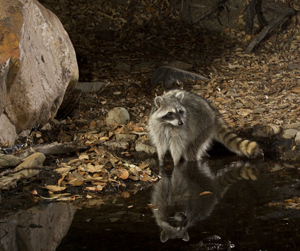
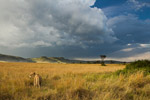

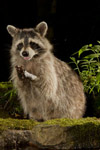
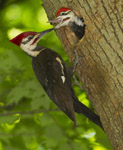


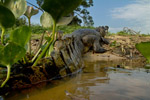
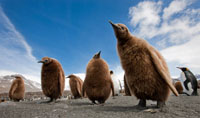
.jpg)

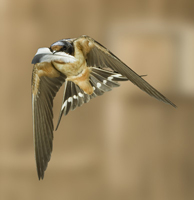
The Ocelot
The Waterhole
Bushbaby
Barn Swallow
King Penguin
The Lion and the Landscape
The Bighorn Sheep
The Raccoon
The Pileated Woodpecker
The Striking Rattlesnake
The Pink Salmon
The Spectacled Caimen
Check out our latest web site,
mcdonaldwildlifephotos.com
where we'll be adding portfolios and eventually building up
a searchable data base for photo buyers. We've just started,
and the selection is limited, but it is still worth a visit!
Office Phone: (717) 543-6423
Or FAX us at: (717) 543-5342
The Story Behind the Photograph
Photographing The African Bats

Two African leaf-nosed bats leave their roost hole, made with a Range IR.
I love photographing bats, probably because a flash photograph of a flying bat reveals a view impossible to see with the naked eye. At night, if a bat can even be seen, most views are limited to fleeting glimpses -- perhaps a silhouette against a sky or a fast-moving phantom darting in and out of the dome of a street lamp or porch light.
I was in northern Tanzania where, near one of our camp sites, I found a roosting site for hundreds of leaf-nosed bats. The roost hole opening was fairly small, and although I had several Range IRs along for another project I found that only one was needed to cover the flight path. I only had two nights at the location and, discovering the roost hole at 4PM on the first day I had only a few hours to rig up some type of setup to photograph the bats as they left the roost.
 .
.
I did not have lightstands along but using some poles I found nearby I was able to erect a frame where I could mount my flashes and the Range IR. In lieu of lightstands I had carried 1/4 - 20 threaded rods that I had found at a local hardware store back in the States. I brought two different sizes, one 12 inches, and another 24 inches. Since the rods were threaded I could screw in mini-ball heads where I could mount my flashes. I secured the rods to the poles by means of bungi cords and nylon parachute cord, although I had some problems with one rod that was extended out from the mounting pole. That rod, when the flash was attached, swiveled on its axis, resulting in the flash aiming down and not at the hole. By lashing the back end securely, giving two points of contact, I finally made the flash fairly secure.
I wasn't completely unprepared for this shoot because I had planned to photograph bushbabies and genets when I was in Kenya. Consequently, I had along a Manfrotto Articulating Arm, Super Clamp, and a smaller mounting clamp that I used to mount a 1x2x24 inch piece of lumber with several 1/4 20 inch bolts attached, for mounting three or four ballheads. I positioned this piece above the roost hole, with a flash on either side of a Range IR. The Range IR was aimed downward so that the infrared beam covered the center of the roost hole. Since the Range IR has a rheostat-like knob for adjusting the distance the beam travels, I could dial in just enough beam to cover the hole, ending the beam 'in space' so that the ground below didn't trigger the system.

A Range IR, like most camera remote traps, can be attached to either a camera or a flash. In this situation only one method would work. Had I attached the Range IR to a camera, every time a bat broke the beam the Range IR would trip the camera, which would be attached to one flash that would set off the other flashes via a wireless slave system. This sounds great, doesn't it? Exactly what you'd want.
Well, no. Because of the lag time involved, that is, the time that elapses between the time that the beam is tripped and the time the camera actually fires, the bat may have traveled far past the beam. Most dSLRs have a lag time of 1/20th of a second or so, which doesn't seem like much but which really is. A bat might fly 20 inches in that duration! Granted, one could compensate in framing and focusing to catch a bat at the right spot based on this lag time, but each bat would have to be traveling in the same direction and at the same speed. In practical terms, this doesn't work.
 When a flash is wired in, there is no lag time, and so, when the beam is broken a flash fires virtually instantaneously. In this way, if you are focused on the path of the beam and you are framed correctly, you'll get the bat every time. But again, there is a catch: the camera shutter must be open when the flash fires. And, if the flash fires more than once while the shutter is open, the camera will record both (or multiple) images. This can result in double-exposures where a bat appears transparent, as the tree bark behind it is revealed in one of the two shots.
When a flash is wired in, there is no lag time, and so, when the beam is broken a flash fires virtually instantaneously. In this way, if you are focused on the path of the beam and you are framed correctly, you'll get the bat every time. But again, there is a catch: the camera shutter must be open when the flash fires. And, if the flash fires more than once while the shutter is open, the camera will record both (or multiple) images. This can result in double-exposures where a bat appears transparent, as the tree bark behind it is revealed in one of the two shots.
 To use the flash, then, I simply put my camera on 'continuous' drive, with the shutter speed set for about 4 seconds. The camera clicked away, sometimes not catching anything in the frame, sometimes (rarely) recording double or multiple exposures, but quite often catching a bat perfectly in the frame. In the dark I couldn't see a thing until the flash fired, when a bat would suddenly be illuminated in wonderful poses. Sometimes, however, the camera's shutter was closed at that instant and I'd miss the shot, but more often than not I would obtain an image.
To use the flash, then, I simply put my camera on 'continuous' drive, with the shutter speed set for about 4 seconds. The camera clicked away, sometimes not catching anything in the frame, sometimes (rarely) recording double or multiple exposures, but quite often catching a bat perfectly in the frame. In the dark I couldn't see a thing until the flash fired, when a bat would suddenly be illuminated in wonderful poses. Sometimes, however, the camera's shutter was closed at that instant and I'd miss the shot, but more often than not I would obtain an image.
I used five flashes for the set-up. Two flashes were mounted on the beam beside the Range IR, another two flashes were mounted on the poles on either side of the roost hole, and the last flash -- the one wired in to the Range IR -- was mounted below the nest hole. I was using a wireless system where the four 'slave' flashes had to 'see' the master flash, and so each flash's receiver was rotated to face the master flash. I used manual mode, rather than TTL flash, because I wanted to have a consistent flash duration, which is not possible on TTL. On TTL, flash duration is based upon f-stop, flash-to-subject distance, ISO, and how much area a subject occupies in the frame. Since the bats' sizes varied by how they positioned their wings this was too variable to risk. On manual, I set my power ratio to 1/64th power, set my ISO at 800, and still had an f16 aperture. The flash was firing at a duration of at least 1/20,000th at the power ratio, although the exact speeds are no longer printed in the flash manuals!

The lagtime issue has been a real hindrance for a lot of this type of work. When I did the striking rattlesnake I had to use Bulb, with the flashes wired to a sensor, because the snake's strike would be completed (that is, the snake would be back in its coil after having struck) before the camera fired. Imagine trying to catch that type of image in a dark room! The chameleons flipping their tongues, or frogs and geckos leaping were also made in this way. Cognisys, the makers of the Range IR, now offer an external high-speed shutter that will make this type of work much easier and safer, and I'm hoping to be trying out that shutter this spring. If so, you'll see the results here in a Story.
There is a remote chance that I may do an Advanced Flash Nature Photo Course this year – if you are interested in this, please contact the office and by the response I’ll decide. In that course I'll be covering TTL and Manual flash, and perhaps more importantly, I'll be demonstrating and teaching techniques with the Range IR and you'll be using this equipment in the projects I'll be assigning you.
The basics of all this flash information will be covered in our Complete Digital Nature Photo Course as well, but not in the depth of the Advanced course. Nonetheless, the CDCNPC would get you started.
The Story Behind the Photograph
Photographing The African Bats

Two African leaf-nosed bats leave their roost hole, made with a Range IR.
I love photographing bats, probably because a flash photograph of a flying bat reveals a view impossible to see with the naked eye. At night, if a bat can even be seen, most views are limited to fleeting glimpses -- perhaps a silhouette against a sky or a fast-moving phantom darting in and out of the dome of a street lamp or porch light.
I was in northern Tanzania where, near one of our camp sites, I found a roosting site for hundreds of leaf-nosed bats. The roost hole opening was fairly small, and although I had several Range IRs along for another project I found that only one was needed to cover the flight path. I only had two nights at the location and, discovering the roost hole at 4PM on the first day I had only a few hours to rig up some type of setup to photograph the bats as they left the roost.
 .
.
I did not have lightstands along but using some poles I found nearby I was able to erect a frame where I could mount my flashes and the Range IR. In lieu of lightstands I had carried 1/4 - 20 threaded rods that I had found at a local hardware store back in the States. I brought two different sizes, one 12 inches, and another 24 inches. Since the rods were threaded I could screw in mini-ball heads where I could mount my flashes. I secured the rods to the poles by means of bungi cords and nylon parachute cord, although I had some problems with one rod that was extended out from the mounting pole. That rod, when the flash was attached, swiveled on its axis, resulting in the flash aiming down and not at the hole. By lashing the back end securely, giving two points of contact, I finally made the flash fairly secure.
I wasn't completely unprepared for this shoot because I had planned to photograph bushbabies and genets when I was in Kenya. Consequently, I had along a Manfrotto Articulating Arm, Super Clamp, and a smaller mounting clamp that I used to mount a 1x2x24 inch piece of lumber with several 1/4 20 inch bolts attached, for mounting three or four ballheads. I positioned this piece above the roost hole, with a flash on either side of a Range IR. The Range IR was aimed downward so that the infrared beam covered the center of the roost hole. Since the Range IR has a rheostat-like knob for adjusting the distance the beam travels, I could dial in just enough beam to cover the hole, ending the beam 'in space' so that the ground below didn't trigger the system.

A Range IR, like most camera remote traps, can be attached to either a camera or a flash. In this situation only one method would work. Had I attached the Range IR to a camera, every time a bat broke the beam the Range IR would trip the camera, which would be attached to one flash that would set off the other flashes via a wireless slave system. This sounds great, doesn't it? Exactly what you'd want.
Well, no. Because of the lag time involved, that is, the time that elapses between the time that the beam is tripped and the time the camera actually fires, the bat may have traveled far past the beam. Most dSLRs have a lag time of 1/20th of a second or so, which doesn't seem like much but which really is. A bat might fly 20 inches in that duration! Granted, one could compensate in framing and focusing to catch a bat at the right spot based on this lag time, but each bat would have to be traveling in the same direction and at the same speed. In practical terms, this doesn't work.
 When a flash is wired in, there is no lag time, and so, when the beam is broken a flash fires virtually instantaneously. In this way, if you are focused on the path of the beam and you are framed correctly, you'll get the bat every time. But again, there is a catch: the camera shutter must be open when the flash fires. And, if the flash fires more than once while the shutter is open, the camera will record both (or multiple) images. This can result in double-exposures where a bat appears transparent, as the tree bark behind it is revealed in one of the two shots.
When a flash is wired in, there is no lag time, and so, when the beam is broken a flash fires virtually instantaneously. In this way, if you are focused on the path of the beam and you are framed correctly, you'll get the bat every time. But again, there is a catch: the camera shutter must be open when the flash fires. And, if the flash fires more than once while the shutter is open, the camera will record both (or multiple) images. This can result in double-exposures where a bat appears transparent, as the tree bark behind it is revealed in one of the two shots.
 To use the flash, then, I simply put my camera on 'continuous' drive, with the shutter speed set for about 4 seconds. The camera clicked away, sometimes not catching anything in the frame, sometimes (rarely) recording double or multiple exposures, but quite often catching a bat perfectly in the frame. In the dark I couldn't see a thing until the flash fired, when a bat would suddenly be illuminated in wonderful poses. Sometimes, however, the camera's shutter was closed at that instant and I'd miss the shot, but more often than not I would obtain an image.
To use the flash, then, I simply put my camera on 'continuous' drive, with the shutter speed set for about 4 seconds. The camera clicked away, sometimes not catching anything in the frame, sometimes (rarely) recording double or multiple exposures, but quite often catching a bat perfectly in the frame. In the dark I couldn't see a thing until the flash fired, when a bat would suddenly be illuminated in wonderful poses. Sometimes, however, the camera's shutter was closed at that instant and I'd miss the shot, but more often than not I would obtain an image.
I used five flashes for the set-up. Two flashes were mounted on the beam beside the Range IR, another two flashes were mounted on the poles on either side of the roost hole, and the last flash -- the one wired in to the Range IR -- was mounted below the nest hole. I was using a wireless system where the four 'slave' flashes had to 'see' the master flash, and so each flash's receiver was rotated to face the master flash. I used manual mode, rather than TTL flash, because I wanted to have a consistent flash duration, which is not possible on TTL. On TTL, flash duration is based upon f-stop, flash-to-subject distance, ISO, and how much area a subject occupies in the frame. Since the bats' sizes varied by how they positioned their wings this was too variable to risk. On manual, I set my power ratio to 1/64th power, set my ISO at 800, and still had an f16 aperture. The flash was firing at a duration of at least 1/20,000th at the power ratio, although the exact speeds are no longer printed in the flash manuals!

The lagtime issue has been a real hindrance for a lot of this type of work. When I did the striking rattlesnake I had to use Bulb, with the flashes wired to a sensor, because the snake's strike would be completed (that is, the snake would be back in its coil after having struck) before the camera fired. Imagine trying to catch that type of image in a dark room! The chameleons flipping their tongues, or frogs and geckos leaping were also made in this way. Cognisys, the makers of the Range IR, now offer an external high-speed shutter that will make this type of work much easier and safer, and I'm hoping to be trying out that shutter this spring. If so, you'll see the results here in a Story.
There is a remote chance that I may do an Advanced Flash Nature Photo Course this year – if you are interested in this, please contact the office and by the response I’ll decide. In that course I'll be covering TTL and Manual flash, and perhaps more importantly, I'll be demonstrating and teaching techniques with the Range IR and you'll be using this equipment in the projects I'll be assigning you.
The basics of all this flash information will be covered in our Complete Digital Nature Photo Course as well, but not in the depth of the Advanced course. Nonetheless, the CDCNPC would get you started.
The Story Behind the Photograph
Photographing The African Bats

Two African leaf-nosed bats leave their roost hole, made with a Range IR.
I love photographing bats, probably because a flash photograph of a flying bat reveals a view impossible to see with the naked eye. At night, if a bat can even be seen, most views are limited to fleeting glimpses -- perhaps a silhouette against a sky or a fast-moving phantom darting in and out of the dome of a street lamp or porch light.
I was in northern Tanzania where, near one of our camp sites, I found a roosting site for hundreds of leaf-nosed bats. The roost hole opening was fairly small, and although I had several Range IRs along for another project I found that only one was needed to cover the flight path. I only had two nights at the location and, discovering the roost hole at 4PM on the first day I had only a few hours to rig up some type of setup to photograph the bats as they left the roost.
 .
.
I did not have lightstands along but using some poles I found nearby I was able to erect a frame where I could mount my flashes and the Range IR. In lieu of lightstands I had carried 1/4 - 20 threaded rods that I had found at a local hardware store back in the States. I brought two different sizes, one 12 inches, and another 24 inches. Since the rods were threaded I could screw in mini-ball heads where I could mount my flashes. I secured the rods to the poles by means of bungi cords and nylon parachute cord, although I had some problems with one rod that was extended out from the mounting pole. That rod, when the flash was attached, swiveled on its axis, resulting in the flash aiming down and not at the hole. By lashing the back end securely, giving two points of contact, I finally made the flash fairly secure.
I wasn't completely unprepared for this shoot because I had planned to photograph bushbabies and genets when I was in Kenya. Consequently, I had along a Manfrotto Articulating Arm, Super Clamp, and a smaller mounting clamp that I used to mount a 1x2x24 inch piece of lumber with several 1/4 20 inch bolts attached, for mounting three or four ballheads. I positioned this piece above the roost hole, with a flash on either side of a Range IR. The Range IR was aimed downward so that the infrared beam covered the center of the roost hole. Since the Range IR has a rheostat-like knob for adjusting the distance the beam travels, I could dial in just enough beam to cover the hole, ending the beam 'in space' so that the ground below didn't trigger the system.

A Range IR, like most camera remote traps, can be attached to either a camera or a flash. In this situation only one method would work. Had I attached the Range IR to a camera, every time a bat broke the beam the Range IR would trip the camera, which would be attached to one flash that would set off the other flashes via a wireless slave system. This sounds great, doesn't it? Exactly what you'd want.
Well, no. Because of the lag time involved, that is, the time that elapses between the time that the beam is tripped and the time the camera actually fires, the bat may have traveled far past the beam. Most dSLRs have a lag time of 1/20th of a second or so, which doesn't seem like much but which really is. A bat might fly 20 inches in that duration! Granted, one could compensate in framing and focusing to catch a bat at the right spot based on this lag time, but each bat would have to be traveling in the same direction and at the same speed. In practical terms, this doesn't work.
 When a flash is wired in, there is no lag time, and so, when the beam is broken a flash fires virtually instantaneously. In this way, if you are focused on the path of the beam and you are framed correctly, you'll get the bat every time. But again, there is a catch: the camera shutter must be open when the flash fires. And, if the flash fires more than once while the shutter is open, the camera will record both (or multiple) images. This can result in double-exposures where a bat appears transparent, as the tree bark behind it is revealed in one of the two shots.
When a flash is wired in, there is no lag time, and so, when the beam is broken a flash fires virtually instantaneously. In this way, if you are focused on the path of the beam and you are framed correctly, you'll get the bat every time. But again, there is a catch: the camera shutter must be open when the flash fires. And, if the flash fires more than once while the shutter is open, the camera will record both (or multiple) images. This can result in double-exposures where a bat appears transparent, as the tree bark behind it is revealed in one of the two shots.
 To use the flash, then, I simply put my camera on 'continuous' drive, with the shutter speed set for about 4 seconds. The camera clicked away, sometimes not catching anything in the frame, sometimes (rarely) recording double or multiple exposures, but quite often catching a bat perfectly in the frame. In the dark I couldn't see a thing until the flash fired, when a bat would suddenly be illuminated in wonderful poses. Sometimes, however, the camera's shutter was closed at that instant and I'd miss the shot, but more often than not I would obtain an image.
To use the flash, then, I simply put my camera on 'continuous' drive, with the shutter speed set for about 4 seconds. The camera clicked away, sometimes not catching anything in the frame, sometimes (rarely) recording double or multiple exposures, but quite often catching a bat perfectly in the frame. In the dark I couldn't see a thing until the flash fired, when a bat would suddenly be illuminated in wonderful poses. Sometimes, however, the camera's shutter was closed at that instant and I'd miss the shot, but more often than not I would obtain an image.
I used five flashes for the set-up. Two flashes were mounted on the beam beside the Range IR, another two flashes were mounted on the poles on either side of the roost hole, and the last flash -- the one wired in to the Range IR -- was mounted below the nest hole. I was using a wireless system where the four 'slave' flashes had to 'see' the master flash, and so each flash's receiver was rotated to face the master flash. I used manual mode, rather than TTL flash, because I wanted to have a consistent flash duration, which is not possible on TTL. On TTL, flash duration is based upon f-stop, flash-to-subject distance, ISO, and how much area a subject occupies in the frame. Since the bats' sizes varied by how they positioned their wings this was too variable to risk. On manual, I set my power ratio to 1/64th power, set my ISO at 800, and still had an f16 aperture. The flash was firing at a duration of at least 1/20,000th at the power ratio, although the exact speeds are no longer printed in the flash manuals!

The lagtime issue has been a real hindrance for a lot of this type of work. When I did the striking rattlesnake I had to use Bulb, with the flashes wired to a sensor, because the snake's strike would be completed (that is, the snake would be back in its coil after having struck) before the camera fired. Imagine trying to catch that type of image in a dark room! The chameleons flipping their tongues, or frogs and geckos leaping were also made in this way. Cognisys, the makers of the Range IR, now offer an external high-speed shutter that will make this type of work much easier and safer, and I'm hoping to be trying out that shutter this spring. If so, you'll see the results here in a Story.
There is a remote chance that I may do an Advanced Flash Nature Photo Course this year – if you are interested in this, please contact the office and by the response I’ll decide. In that course I'll be covering TTL and Manual flash, and perhaps more importantly, I'll be demonstrating and teaching techniques with the Range IR and you'll be using this equipment in the projects I'll be assigning you.
The basics of all this flash information will be covered in our Complete Digital Nature Photo Course as well, but not in the depth of the Advanced course. Nonetheless, the CDCNPC would get you started.
The Story Behind the Photograph
Photographing The African Bats

Two African leaf-nosed bats leave their roost hole, made with a Range IR.
I love photographing bats, probably because a flash photograph of a flying bat reveals a view impossible to see with the naked eye. At night, if a bat can even be seen, most views are limited to fleeting glimpses -- perhaps a silhouette against a sky or a fast-moving phantom darting in and out of the dome of a street lamp or porch light.
I was in northern Tanzania where, near one of our camp sites, I found a roosting site for hundreds of leaf-nosed bats. The roost hole opening was fairly small, and although I had several Range IRs along for another project I found that only one was needed to cover the flight path. I only had two nights at the location and, discovering the roost hole at 4PM on the first day I had only a few hours to rig up some type of setup to photograph the bats as they left the roost.
 .
.
I did not have lightstands along but using some poles I found nearby I was able to erect a frame where I could mount my flashes and the Range IR. In lieu of lightstands I had carried 1/4 - 20 threaded rods that I had found at a local hardware store back in the States. I brought two different sizes, one 12 inches, and another 24 inches. Since the rods were threaded I could screw in mini-ball heads where I could mount my flashes. I secured the rods to the poles by means of bungi cords and nylon parachute cord, although I had some problems with one rod that was extended out from the mounting pole. That rod, when the flash was attached, swiveled on its axis, resulting in the flash aiming down and not at the hole. By lashing the back end securely, giving two points of contact, I finally made the flash fairly secure.
I wasn't completely unprepared for this shoot because I had planned to photograph bushbabies and genets when I was in Kenya. Consequently, I had along a Manfrotto Articulating Arm, Super Clamp, and a smaller mounting clamp that I used to mount a 1x2x24 inch piece of lumber with several 1/4 20 inch bolts attached, for mounting three or four ballheads. I positioned this piece above the roost hole, with a flash on either side of a Range IR. The Range IR was aimed downward so that the infrared beam covered the center of the roost hole. Since the Range IR has a rheostat-like knob for adjusting the distance the beam travels, I could dial in just enough beam to cover the hole, ending the beam 'in space' so that the ground below didn't trigger the system.

A Range IR, like most camera remote traps, can be attached to either a camera or a flash. In this situation only one method would work. Had I attached the Range IR to a camera, every time a bat broke the beam the Range IR would trip the camera, which would be attached to one flash that would set off the other flashes via a wireless slave system. This sounds great, doesn't it? Exactly what you'd want.
Well, no. Because of the lag time involved, that is, the time that elapses between the time that the beam is tripped and the time the camera actually fires, the bat may have traveled far past the beam. Most dSLRs have a lag time of 1/20th of a second or so, which doesn't seem like much but which really is. A bat might fly 20 inches in that duration! Granted, one could compensate in framing and focusing to catch a bat at the right spot based on this lag time, but each bat would have to be traveling in the same direction and at the same speed. In practical terms, this doesn't work.
 When a flash is wired in, there is no lag time, and so, when the beam is broken a flash fires virtually instantaneously. In this way, if you are focused on the path of the beam and you are framed correctly, you'll get the bat every time. But again, there is a catch: the camera shutter must be open when the flash fires. And, if the flash fires more than once while the shutter is open, the camera will record both (or multiple) images. This can result in double-exposures where a bat appears transparent, as the tree bark behind it is revealed in one of the two shots.
When a flash is wired in, there is no lag time, and so, when the beam is broken a flash fires virtually instantaneously. In this way, if you are focused on the path of the beam and you are framed correctly, you'll get the bat every time. But again, there is a catch: the camera shutter must be open when the flash fires. And, if the flash fires more than once while the shutter is open, the camera will record both (or multiple) images. This can result in double-exposures where a bat appears transparent, as the tree bark behind it is revealed in one of the two shots.
 To use the flash, then, I simply put my camera on 'continuous' drive, with the shutter speed set for about 4 seconds. The camera clicked away, sometimes not catching anything in the frame, sometimes (rarely) recording double or multiple exposures, but quite often catching a bat perfectly in the frame. In the dark I couldn't see a thing until the flash fired, when a bat would suddenly be illuminated in wonderful poses. Sometimes, however, the camera's shutter was closed at that instant and I'd miss the shot, but more often than not I would obtain an image.
To use the flash, then, I simply put my camera on 'continuous' drive, with the shutter speed set for about 4 seconds. The camera clicked away, sometimes not catching anything in the frame, sometimes (rarely) recording double or multiple exposures, but quite often catching a bat perfectly in the frame. In the dark I couldn't see a thing until the flash fired, when a bat would suddenly be illuminated in wonderful poses. Sometimes, however, the camera's shutter was closed at that instant and I'd miss the shot, but more often than not I would obtain an image.
I used five flashes for the set-up. Two flashes were mounted on the beam beside the Range IR, another two flashes were mounted on the poles on either side of the roost hole, and the last flash -- the one wired in to the Range IR -- was mounted below the nest hole. I was using a wireless system where the four 'slave' flashes had to 'see' the master flash, and so each flash's receiver was rotated to face the master flash. I used manual mode, rather than TTL flash, because I wanted to have a consistent flash duration, which is not possible on TTL. On TTL, flash duration is based upon f-stop, flash-to-subject distance, ISO, and how much area a subject occupies in the frame. Since the bats' sizes varied by how they positioned their wings this was too variable to risk. On manual, I set my power ratio to 1/64th power, set my ISO at 800, and still had an f16 aperture. The flash was firing at a duration of at least 1/20,000th at the power ratio, although the exact speeds are no longer printed in the flash manuals!

The lagtime issue has been a real hindrance for a lot of this type of work. When I did the striking rattlesnake I had to use Bulb, with the flashes wired to a sensor, because the snake's strike would be completed (that is, the snake would be back in its coil after having struck) before the camera fired. Imagine trying to catch that type of image in a dark room! The chameleons flipping their tongues, or frogs and geckos leaping were also made in this way. Cognisys, the makers of the Range IR, now offer an external high-speed shutter that will make this type of work much easier and safer, and I'm hoping to be trying out that shutter this spring. If so, you'll see the results here in a Story.
There is a remote chance that I may do an Advanced Flash Nature Photo Course this year – if you are interested in this, please contact the office and by the response I’ll decide. In that course I'll be covering TTL and Manual flash, and perhaps more importantly, I'll be demonstrating and teaching techniques with the Range IR and you'll be using this equipment in the projects I'll be assigning you.
The basics of all this flash information will be covered in our Complete Digital Nature Photo Course as well, but not in the depth of the Advanced course. Nonetheless, the CDCNPC would get you started.
The Story Behind the Photograph
Photographing The African Bats

Two African leaf-nosed bats leave their roost hole, made with a Range IR.
I love photographing bats, probably because a flash photograph of a flying bat reveals a view impossible to see with the naked eye. At night, if a bat can even be seen, most views are limited to fleeting glimpses -- perhaps a silhouette against a sky or a fast-moving phantom darting in and out of the dome of a street lamp or porch light.
I was in northern Tanzania where, near one of our camp sites, I found a roosting site for hundreds of leaf-nosed bats. The roost hole opening was fairly small, and although I had several Range IRs along for another project I found that only one was needed to cover the flight path. I only had two nights at the location and, discovering the roost hole at 4PM on the first day I had only a few hours to rig up some type of setup to photograph the bats as they left the roost.
 .
.
I did not have lightstands along but using some poles I found nearby I was able to erect a frame where I could mount my flashes and the Range IR. In lieu of lightstands I had carried 1/4 - 20 threaded rods that I had found at a local hardware store back in the States. I brought two different sizes, one 12 inches, and another 24 inches. Since the rods were threaded I could screw in mini-ball heads where I could mount my flashes. I secured the rods to the poles by means of bungi cords and nylon parachute cord, although I had some problems with one rod that was extended out from the mounting pole. That rod, when the flash was attached, swiveled on its axis, resulting in the flash aiming down and not at the hole. By lashing the back end securely, giving two points of contact, I finally made the flash fairly secure.
I wasn't completely unprepared for this shoot because I had planned to photograph bushbabies and genets when I was in Kenya. Consequently, I had along a Manfrotto Articulating Arm, Super Clamp, and a smaller mounting clamp that I used to mount a 1x2x24 inch piece of lumber with several 1/4 20 inch bolts attached, for mounting three or four ballheads. I positioned this piece above the roost hole, with a flash on either side of a Range IR. The Range IR was aimed downward so that the infrared beam covered the center of the roost hole. Since the Range IR has a rheostat-like knob for adjusting the distance the beam travels, I could dial in just enough beam to cover the hole, ending the beam 'in space' so that the ground below didn't trigger the system.

A Range IR, like most camera remote traps, can be attached to either a camera or a flash. In this situation only one method would work. Had I attached the Range IR to a camera, every time a bat broke the beam the Range IR would trip the camera, which would be attached to one flash that would set off the other flashes via a wireless slave system. This sounds great, doesn't it? Exactly what you'd want.
Well, no. Because of the lag time involved, that is, the time that elapses between the time that the beam is tripped and the time the camera actually fires, the bat may have traveled far past the beam. Most dSLRs have a lag time of 1/20th of a second or so, which doesn't seem like much but which really is. A bat might fly 20 inches in that duration! Granted, one could compensate in framing and focusing to catch a bat at the right spot based on this lag time, but each bat would have to be traveling in the same direction and at the same speed. In practical terms, this doesn't work.
 When a flash is wired in, there is no lag time, and so, when the beam is broken a flash fires virtually instantaneously. In this way, if you are focused on the path of the beam and you are framed correctly, you'll get the bat every time. But again, there is a catch: the camera shutter must be open when the flash fires. And, if the flash fires more than once while the shutter is open, the camera will record both (or multiple) images. This can result in double-exposures where a bat appears transparent, as the tree bark behind it is revealed in one of the two shots.
When a flash is wired in, there is no lag time, and so, when the beam is broken a flash fires virtually instantaneously. In this way, if you are focused on the path of the beam and you are framed correctly, you'll get the bat every time. But again, there is a catch: the camera shutter must be open when the flash fires. And, if the flash fires more than once while the shutter is open, the camera will record both (or multiple) images. This can result in double-exposures where a bat appears transparent, as the tree bark behind it is revealed in one of the two shots.
 To use the flash, then, I simply put my camera on 'continuous' drive, with the shutter speed set for about 4 seconds. The camera clicked away, sometimes not catching anything in the frame, sometimes (rarely) recording double or multiple exposures, but quite often catching a bat perfectly in the frame. In the dark I couldn't see a thing until the flash fired, when a bat would suddenly be illuminated in wonderful poses. Sometimes, however, the camera's shutter was closed at that instant and I'd miss the shot, but more often than not I would obtain an image.
To use the flash, then, I simply put my camera on 'continuous' drive, with the shutter speed set for about 4 seconds. The camera clicked away, sometimes not catching anything in the frame, sometimes (rarely) recording double or multiple exposures, but quite often catching a bat perfectly in the frame. In the dark I couldn't see a thing until the flash fired, when a bat would suddenly be illuminated in wonderful poses. Sometimes, however, the camera's shutter was closed at that instant and I'd miss the shot, but more often than not I would obtain an image.
I used five flashes for the set-up. Two flashes were mounted on the beam beside the Range IR, another two flashes were mounted on the poles on either side of the roost hole, and the last flash -- the one wired in to the Range IR -- was mounted below the nest hole. I was using a wireless system where the four 'slave' flashes had to 'see' the master flash, and so each flash's receiver was rotated to face the master flash. I used manual mode, rather than TTL flash, because I wanted to have a consistent flash duration, which is not possible on TTL. On TTL, flash duration is based upon f-stop, flash-to-subject distance, ISO, and how much area a subject occupies in the frame. Since the bats' sizes varied by how they positioned their wings this was too variable to risk. On manual, I set my power ratio to 1/64th power, set my ISO at 800, and still had an f16 aperture. The flash was firing at a duration of at least 1/20,000th at the power ratio, although the exact speeds are no longer printed in the flash manuals!

The lagtime issue has been a real hindrance for a lot of this type of work. When I did the striking rattlesnake I had to use Bulb, with the flashes wired to a sensor, because the snake's strike would be completed (that is, the snake would be back in its coil after having struck) before the camera fired. Imagine trying to catch that type of image in a dark room! The chameleons flipping their tongues, or frogs and geckos leaping were also made in this way. Cognisys, the makers of the Range IR, now offer an external high-speed shutter that will make this type of work much easier and safer, and I'm hoping to be trying out that shutter this spring. If so, you'll see the results here in a Story.
There is a remote chance that I may do an Advanced Flash Nature Photo Course this year – if you are interested in this, please contact the office and by the response I’ll decide. In that course I'll be covering TTL and Manual flash, and perhaps more importantly, I'll be demonstrating and teaching techniques with the Range IR and you'll be using this equipment in the projects I'll be assigning you.
The basics of all this flash information will be covered in our Complete Digital Nature Photo Course as well, but not in the depth of the Advanced course. Nonetheless, the CDCNPC would get you started.
The Story Behind the Photograph
Photographing The African Bats

Two African leaf-nosed bats leave their roost hole, made with a Range IR.
I love photographing bats, probably because a flash photograph of a flying bat reveals a view impossible to see with the naked eye. At night, if a bat can even be seen, most views are limited to fleeting glimpses -- perhaps a silhouette against a sky or a fast-moving phantom darting in and out of the dome of a street lamp or porch light.
I was in northern Tanzania where, near one of our camp sites, I found a roosting site for hundreds of leaf-nosed bats. The roost hole opening was fairly small, and although I had several Range IRs along for another project I found that only one was needed to cover the flight path. I only had two nights at the location and, discovering the roost hole at 4PM on the first day I had only a few hours to rig up some type of setup to photograph the bats as they left the roost.
 .
.
I did not have lightstands along but using some poles I found nearby I was able to erect a frame where I could mount my flashes and the Range IR. In lieu of lightstands I had carried 1/4 - 20 threaded rods that I had found at a local hardware store back in the States. I brought two different sizes, one 12 inches, and another 24 inches. Since the rods were threaded I could screw in mini-ball heads where I could mount my flashes. I secured the rods to the poles by means of bungi cords and nylon parachute cord, although I had some problems with one rod that was extended out from the mounting pole. That rod, when the flash was attached, swiveled on its axis, resulting in the flash aiming down and not at the hole. By lashing the back end securely, giving two points of contact, I finally made the flash fairly secure.
I wasn't completely unprepared for this shoot because I had planned to photograph bushbabies and genets when I was in Kenya. Consequently, I had along a Manfrotto Articulating Arm, Super Clamp, and a smaller mounting clamp that I used to mount a 1x2x24 inch piece of lumber with several 1/4 20 inch bolts attached, for mounting three or four ballheads. I positioned this piece above the roost hole, with a flash on either side of a Range IR. The Range IR was aimed downward so that the infrared beam covered the center of the roost hole. Since the Range IR has a rheostat-like knob for adjusting the distance the beam travels, I could dial in just enough beam to cover the hole, ending the beam 'in space' so that the ground below didn't trigger the system.

A Range IR, like most camera remote traps, can be attached to either a camera or a flash. In this situation only one method would work. Had I attached the Range IR to a camera, every time a bat broke the beam the Range IR would trip the camera, which would be attached to one flash that would set off the other flashes via a wireless slave system. This sounds great, doesn't it? Exactly what you'd want.
Well, no. Because of the lag time involved, that is, the time that elapses between the time that the beam is tripped and the time the camera actually fires, the bat may have traveled far past the beam. Most dSLRs have a lag time of 1/20th of a second or so, which doesn't seem like much but which really is. A bat might fly 20 inches in that duration! Granted, one could compensate in framing and focusing to catch a bat at the right spot based on this lag time, but each bat would have to be traveling in the same direction and at the same speed. In practical terms, this doesn't work.
 When a flash is wired in, there is no lag time, and so, when the beam is broken a flash fires virtually instantaneously. In this way, if you are focused on the path of the beam and you are framed correctly, you'll get the bat every time. But again, there is a catch: the camera shutter must be open when the flash fires. And, if the flash fires more than once while the shutter is open, the camera will record both (or multiple) images. This can result in double-exposures where a bat appears transparent, as the tree bark behind it is revealed in one of the two shots.
When a flash is wired in, there is no lag time, and so, when the beam is broken a flash fires virtually instantaneously. In this way, if you are focused on the path of the beam and you are framed correctly, you'll get the bat every time. But again, there is a catch: the camera shutter must be open when the flash fires. And, if the flash fires more than once while the shutter is open, the camera will record both (or multiple) images. This can result in double-exposures where a bat appears transparent, as the tree bark behind it is revealed in one of the two shots.
 To use the flash, then, I simply put my camera on 'continuous' drive, with the shutter speed set for about 4 seconds. The camera clicked away, sometimes not catching anything in the frame, sometimes (rarely) recording double or multiple exposures, but quite often catching a bat perfectly in the frame. In the dark I couldn't see a thing until the flash fired, when a bat would suddenly be illuminated in wonderful poses. Sometimes, however, the camera's shutter was closed at that instant and I'd miss the shot, but more often than not I would obtain an image.
To use the flash, then, I simply put my camera on 'continuous' drive, with the shutter speed set for about 4 seconds. The camera clicked away, sometimes not catching anything in the frame, sometimes (rarely) recording double or multiple exposures, but quite often catching a bat perfectly in the frame. In the dark I couldn't see a thing until the flash fired, when a bat would suddenly be illuminated in wonderful poses. Sometimes, however, the camera's shutter was closed at that instant and I'd miss the shot, but more often than not I would obtain an image.
I used five flashes for the set-up. Two flashes were mounted on the beam beside the Range IR, another two flashes were mounted on the poles on either side of the roost hole, and the last flash -- the one wired in to the Range IR -- was mounted below the nest hole. I was using a wireless system where the four 'slave' flashes had to 'see' the master flash, and so each flash's receiver was rotated to face the master flash. I used manual mode, rather than TTL flash, because I wanted to have a consistent flash duration, which is not possible on TTL. On TTL, flash duration is based upon f-stop, flash-to-subject distance, ISO, and how much area a subject occupies in the frame. Since the bats' sizes varied by how they positioned their wings this was too variable to risk. On manual, I set my power ratio to 1/64th power, set my ISO at 800, and still had an f16 aperture. The flash was firing at a duration of at least 1/20,000th at the power ratio, although the exact speeds are no longer printed in the flash manuals!

The lagtime issue has been a real hindrance for a lot of this type of work. When I did the striking rattlesnake I had to use Bulb, with the flashes wired to a sensor, because the snake's strike would be completed (that is, the snake would be back in its coil after having struck) before the camera fired. Imagine trying to catch that type of image in a dark room! The chameleons flipping their tongues, or frogs and geckos leaping were also made in this way. Cognisys, the makers of the Range IR, now offer an external high-speed shutter that will make this type of work much easier and safer, and I'm hoping to be trying out that shutter this spring. If so, you'll see the results here in a Story.
There is a remote chance that I may do an Advanced Flash Nature Photo Course this year – if you are interested in this, please contact the office and by the response I’ll decide. In that course I'll be covering TTL and Manual flash, and perhaps more importantly, I'll be demonstrating and teaching techniques with the Range IR and you'll be using this equipment in the projects I'll be assigning you.
The basics of all this flash information will be covered in our Complete Digital Nature Photo Course as well, but not in the depth of the Advanced course. Nonetheless, the CDCNPC would get you started.
Past Stories Behind the Photograph









.jpg)


The Ocelot
The Waterhole
Bushbaby
Barn Swallow
King Penguin
The Lion and the Landscape
The Bighorn Sheep
The Raccoon
The Pileated Woodpecker
The Striking Rattlesnake
The Pink Salmon
The Spectacled Caimen
Check out our latest web site,
mcdonaldwildlifephotos.com
where we'll be adding portfolios and eventually building up
a searchable data base for photo buyers. We've just started,
and the selection is limited, but it is still worth a visit!
Past Stories Behind the Photograph









.jpg)


The Ocelot
The Waterhole
Bushbaby
Barn Swallow
King Penguin
The Lion and the Landscape
The Bighorn Sheep
The Raccoon
The Pileated Woodpecker
The Striking Rattlesnake
The Pink Salmon
The Spectacled Caimen
Check out our latest web site,
mcdonaldwildlifephotos.com
where we'll be adding portfolios and eventually building up
a searchable data base for photo buyers. We've just started,
and the selection is limited, but it is still worth a visit!
Office Phone: (717) 543-6423
Or FAX us at: (717) 543-5342


